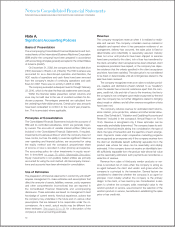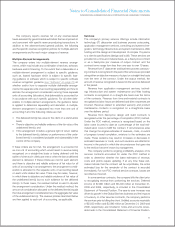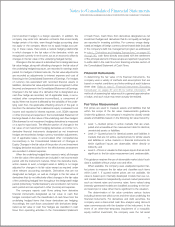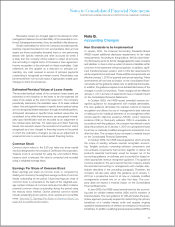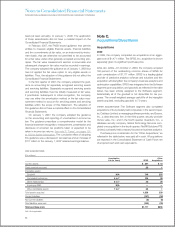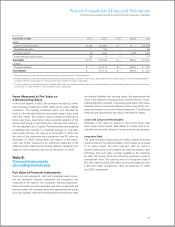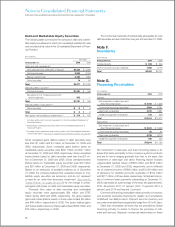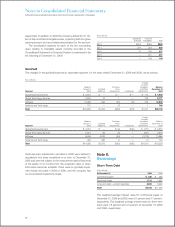IBM 2009 Annual Report Download - page 82
Download and view the complete annual report
Please find page 82 of the 2009 IBM annual report below. You can navigate through the pages in the report by either clicking on the pages listed below, or by using the keyword search tool below to find specific information within the annual report.
Notes to Consolidated Financial Statements
INTERNATIONAL BUSINESS MACHINES CORPORATION AND SUBSIDIARY COMPANIES
are no longer exempt from consolidation under the amended
guidance. The amendments also limit the circumstances in which
a financial asset, or a portion of a financial asset, should be derec-
ognized when the transferor has not transferred the entire original
financial asset to an entity that is not consolidated with the trans-
feror in the financial statements being presented, and/or when
the transferor has continuing involvement with the transferred
financial asset. The company will adopt these amendments
for interim and annual reporting periods beginning on January
1, 2010. The company does not expect the adoption of these
amendments to have a material impact on the Consolidated
Financial Statements.
Standards Implemented
In September 2009, the FASB issued amended guidance con-
cerning fair value measurements of investments in certain entities
that calculate net asset value per share (or its equivalent). If fair
value is not readily determinable, the amended guidance permits,
as a practical expedient, a reporting entity to measure the fair
value of an investment using the net asset value per share (or its
equivalent) provided by the investee without further adjustment.
In accordance with the guidance, the company adopted these
amendments for the year ended December 31, 2009. There was
no material impact on the Consolidated Financial Statements.
On July 1, 2009, the FASB issued the FASB Accounting
Standards Codification (the Codification). The Codification became
the single source of authoritative nongovernmental U.S. GAAP,
superseding existing FASB, American Institute of Certified Public
Accountants (AICPA), Emerging Issues Task Force (EITF) and
related literature. The Codification eliminates the previous U.S.
GAAP hierarchy and establishes one level of authoritative GAAP.
All other literature is considered non-authoritative. The Codifica-
tion was effective for interim and annual periods ending after
September 15, 2009. The company adopted the Codification for
the quarter ending September 30, 2009. There was no impact
to the consolidated financial results.
In May 2009, the FASB issued guidelines on subsequent
event accounting which sets forth: 1) the period after the bal-
ance sheet date during which management of a reporting entity
should evaluate events or transactions that may occur for poten-
tial recognition or disclosure in the financial statements; 2) the
circumstances under which an entity should recognize events
or transactions occurring after the balance sheet date in its
financial statements; and 3) the disclosures that an entity should
make about events or transactions that occurred after the bal-
ance sheet date. These guidelines were effective for interim and
annual periods ending after June 15, 2009, and the company
adopted them in the quarter ended June 30, 2009. There was
no impact on the consolidated financial results.
In April 2009, the FASB issued additional requirements regard-
ing interim disclosures about the fair value of financial instruments
which were previously only disclosed on an annual basis. Entities
are now required to disclose the fair value of financial instruments
which are not recorded at fair value in the financial statements in
both interim and annual financial statements. The new require-
ments were effective for interim and annual periods ending after
June 15, 2009 on a prospective basis. The company adopted
these requirements in the quarter ended June 30, 2009. There
was no impact on the consolidated financial results as this relates
only to additional disclosures in the quarterly financial statements.
See note E, “Financial Instruments (Excluding Derivatives)”, on
pages 87 and 88.
On January 1, 2009, the company adopted the revised FASB
guidance regarding business combinations which was required
to be applied to business combinations on a prospective basis.
The revised guidance requires that the acquisition method of
accounting be applied to a broader set of business combina-
tions, amends the definition of a business combination, provides
a definition of a business, requires an acquirer to recognize
an acquired business at its fair value at the acquisition date
and requires the assets and liabilities assumed in a business
combination to be measured and recognized at their fair values
as of the acquisition date (with limited exceptions). There was
no impact upon adoption and the effects of this guidance will
depend on the nature and significance of business combinations
occurring after the effective date. See note C, “Acquisitions/
Divestitures”, on pages 82 to 86 for further information regarding
2009 business combinations.
In April 2009, the FASB issued an amendment to the revised
business combination guidance regarding the accounting for
assets acquired and liabilities assumed in a business combi-
nation that arise from contingencies. The requirements of this
amended guidance carry forward without significant revision
the guidance on contingencies which existed prior to January
1, 2009. Assets acquired and liabilities assumed in a business
combination that arise from contingencies are recognized at fair
value if fair value can be reasonably estimated. If fair value can-
not be reasonably estimated, the asset or liability would generally
be recognized in accordance with the Accounting Standards
Codification (ASC) Topic 450 on contingencies. There was no
impact upon adoption. See note C, “Acquisitions/Divestitures”,
on pages 82 to 86 for further information regarding 2009 busi-
ness combinations.
In April 2008, the FASB issued new requirements regard-
ing the determination of the useful lives of intangible assets. In
developing assumptions about renewal or extension options
used to determine the useful life of an intangible asset, an entity
needs to consider its own historical experience adjusted for
entity-specific factors. In the absence of that experience, an
entity shall consider the assumptions that market participants
would use about renewal or extension options. The new require-
ments apply to intangible assets acquired after January 1, 2009.
The adoption of these new rules did not have a material impact
on the Consolidated Financial Statements.
80


